Leadership & Management: Applying Theories to Real-World Cases
VerifiedAdded on 2024/06/03
|14
|4144
|426
Case Study
AI Summary
This case study explores the roles of leaders and managers within organizations, contrasting their characteristics and functions using examples from Wells Fargo and Amazon. It examines leadership theory models such as situational and contingency leadership, applying them to real-world scenarios. The analysis covers key approaches in organizational management, particularly focusing on Amazon's operational strategies, the importance of operations management in achieving business goals, and the factors affecting Amazon's operations. Furthermore, the study highlights the importance of decision-making by leaders and managers in maintaining organizational effectiveness and achieving strategic objectives.
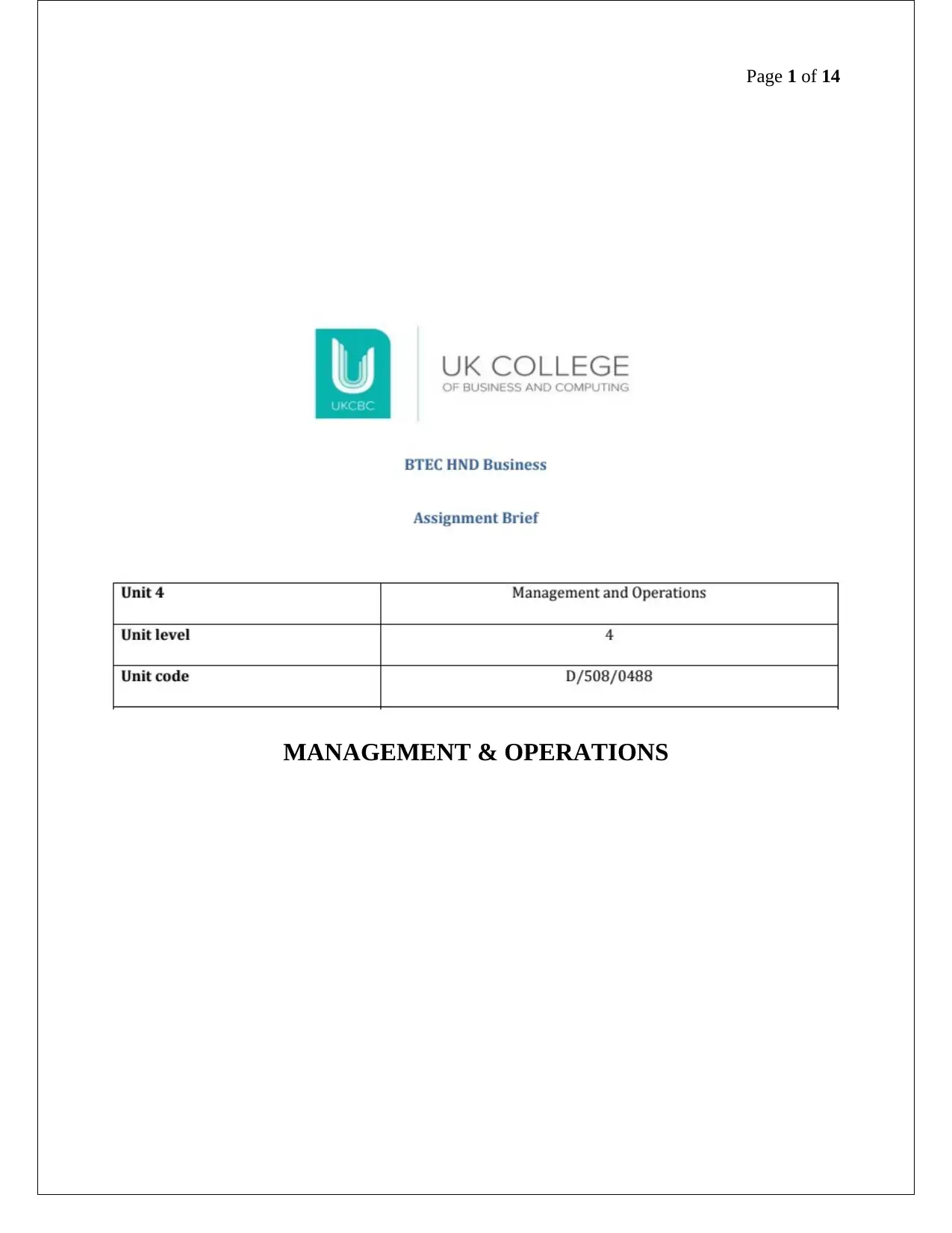
Page 1 of 14
MANAGEMENT & OPERATIONS
MANAGEMENT & OPERATIONS
Paraphrase This Document
Need a fresh take? Get an instant paraphrase of this document with our AI Paraphraser
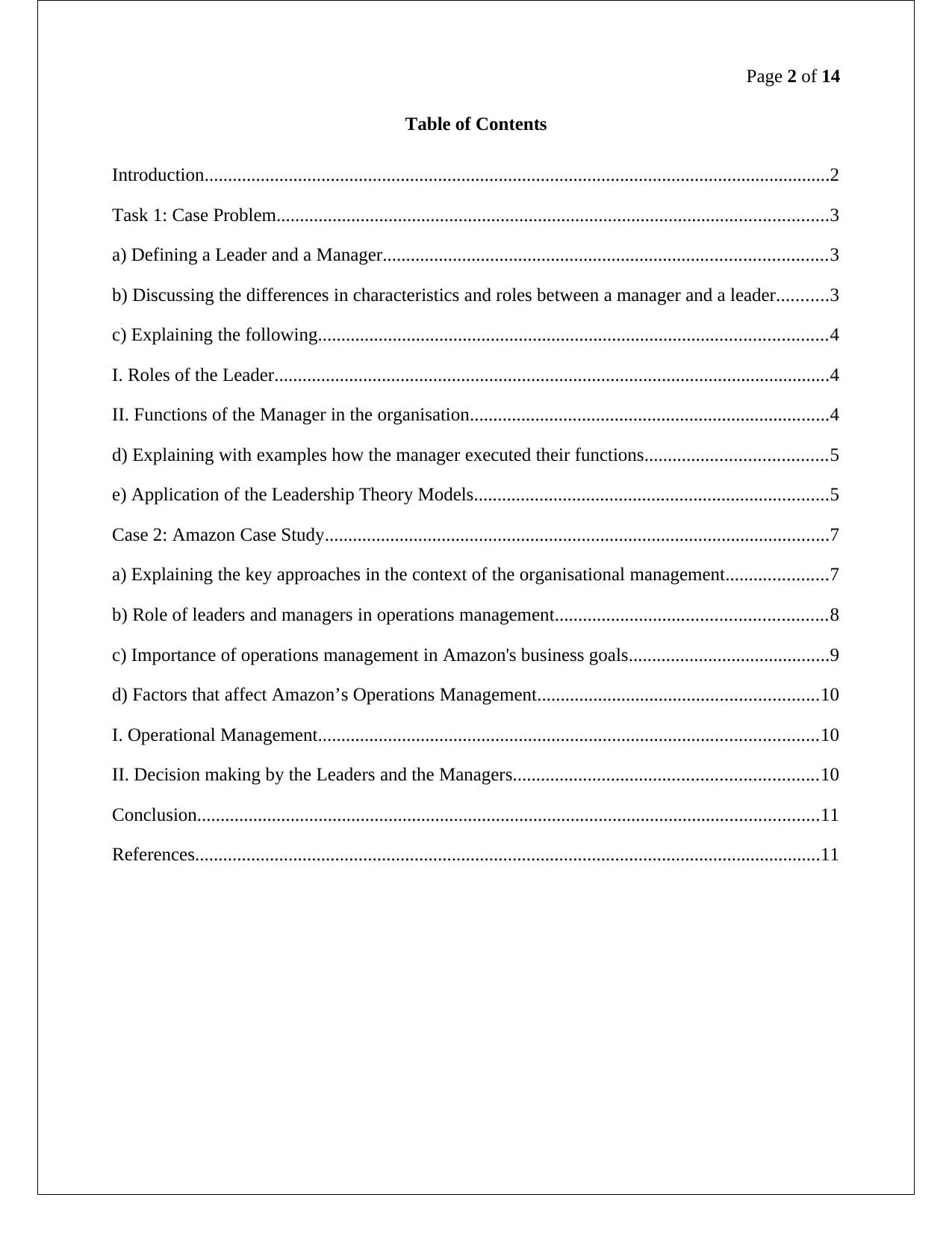
Page 2 of 14
Table of Contents
Introduction......................................................................................................................................2
Task 1: Case Problem......................................................................................................................3
a) Defining a Leader and a Manager...............................................................................................3
b) Discussing the differences in characteristics and roles between a manager and a leader...........3
c) Explaining the following.............................................................................................................4
I. Roles of the Leader.......................................................................................................................4
II. Functions of the Manager in the organisation.............................................................................4
d) Explaining with examples how the manager executed their functions.......................................5
e) Application of the Leadership Theory Models............................................................................5
Case 2: Amazon Case Study............................................................................................................7
a) Explaining the key approaches in the context of the organisational management......................7
b) Role of leaders and managers in operations management..........................................................8
c) Importance of operations management in Amazon's business goals...........................................9
d) Factors that affect Amazon’s Operations Management............................................................10
I. Operational Management...........................................................................................................10
II. Decision making by the Leaders and the Managers.................................................................10
Conclusion.....................................................................................................................................11
References......................................................................................................................................11
Table of Contents
Introduction......................................................................................................................................2
Task 1: Case Problem......................................................................................................................3
a) Defining a Leader and a Manager...............................................................................................3
b) Discussing the differences in characteristics and roles between a manager and a leader...........3
c) Explaining the following.............................................................................................................4
I. Roles of the Leader.......................................................................................................................4
II. Functions of the Manager in the organisation.............................................................................4
d) Explaining with examples how the manager executed their functions.......................................5
e) Application of the Leadership Theory Models............................................................................5
Case 2: Amazon Case Study............................................................................................................7
a) Explaining the key approaches in the context of the organisational management......................7
b) Role of leaders and managers in operations management..........................................................8
c) Importance of operations management in Amazon's business goals...........................................9
d) Factors that affect Amazon’s Operations Management............................................................10
I. Operational Management...........................................................................................................10
II. Decision making by the Leaders and the Managers.................................................................10
Conclusion.....................................................................................................................................11
References......................................................................................................................................11

Page 3 of 14
⊘ This is a preview!⊘
Do you want full access?
Subscribe today to unlock all pages.

Trusted by 1+ million students worldwide
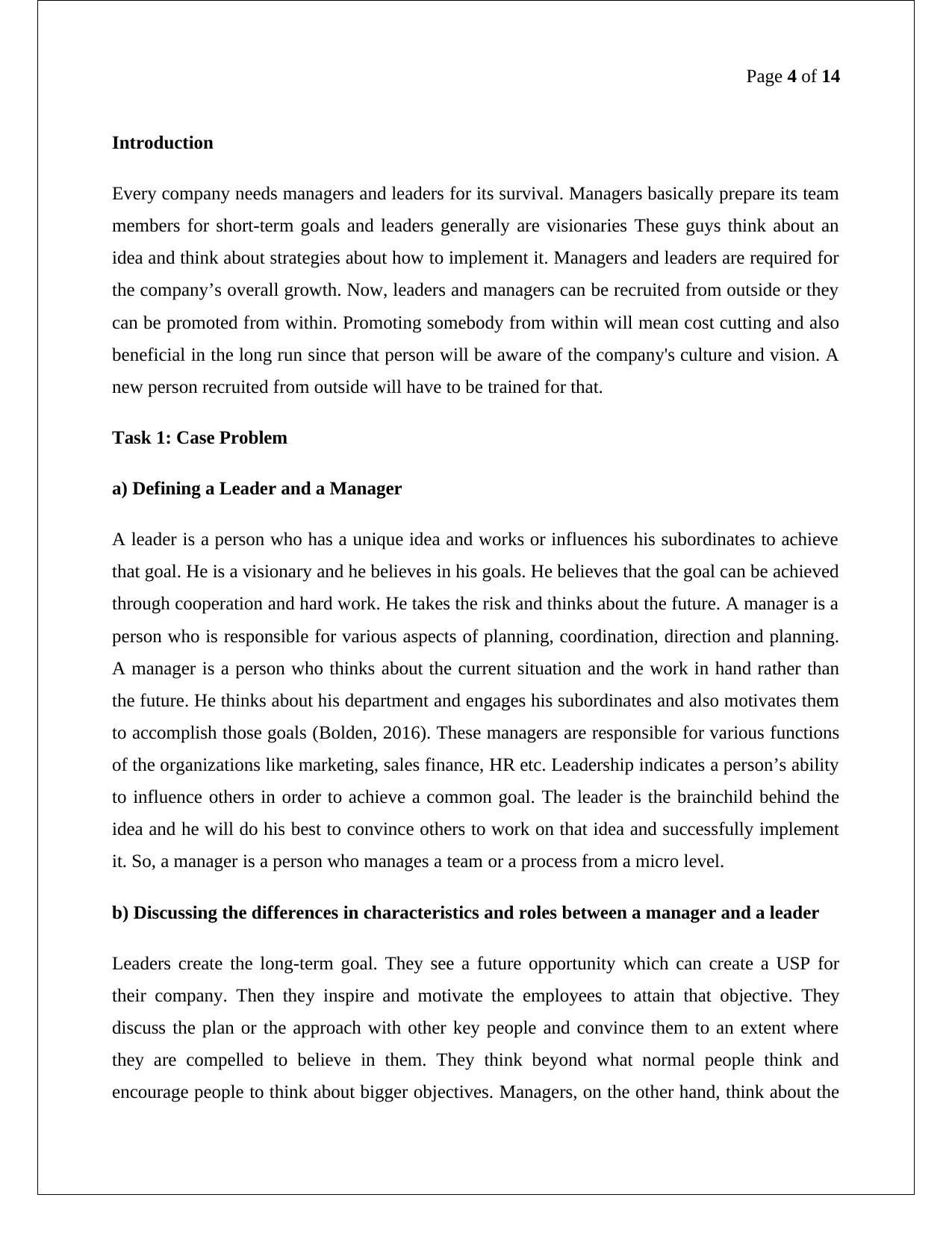
Page 4 of 14
Introduction
Every company needs managers and leaders for its survival. Managers basically prepare its team
members for short-term goals and leaders generally are visionaries These guys think about an
idea and think about strategies about how to implement it. Managers and leaders are required for
the company’s overall growth. Now, leaders and managers can be recruited from outside or they
can be promoted from within. Promoting somebody from within will mean cost cutting and also
beneficial in the long run since that person will be aware of the company's culture and vision. A
new person recruited from outside will have to be trained for that.
Task 1: Case Problem
a) Defining a Leader and a Manager
A leader is a person who has a unique idea and works or influences his subordinates to achieve
that goal. He is a visionary and he believes in his goals. He believes that the goal can be achieved
through cooperation and hard work. He takes the risk and thinks about the future. A manager is a
person who is responsible for various aspects of planning, coordination, direction and planning.
A manager is a person who thinks about the current situation and the work in hand rather than
the future. He thinks about his department and engages his subordinates and also motivates them
to accomplish those goals (Bolden, 2016). These managers are responsible for various functions
of the organizations like marketing, sales finance, HR etc. Leadership indicates a person’s ability
to influence others in order to achieve a common goal. The leader is the brainchild behind the
idea and he will do his best to convince others to work on that idea and successfully implement
it. So, a manager is a person who manages a team or a process from a micro level.
b) Discussing the differences in characteristics and roles between a manager and a leader
Leaders create the long-term goal. They see a future opportunity which can create a USP for
their company. Then they inspire and motivate the employees to attain that objective. They
discuss the plan or the approach with other key people and convince them to an extent where
they are compelled to believe in them. They think beyond what normal people think and
encourage people to think about bigger objectives. Managers, on the other hand, think about the
Introduction
Every company needs managers and leaders for its survival. Managers basically prepare its team
members for short-term goals and leaders generally are visionaries These guys think about an
idea and think about strategies about how to implement it. Managers and leaders are required for
the company’s overall growth. Now, leaders and managers can be recruited from outside or they
can be promoted from within. Promoting somebody from within will mean cost cutting and also
beneficial in the long run since that person will be aware of the company's culture and vision. A
new person recruited from outside will have to be trained for that.
Task 1: Case Problem
a) Defining a Leader and a Manager
A leader is a person who has a unique idea and works or influences his subordinates to achieve
that goal. He is a visionary and he believes in his goals. He believes that the goal can be achieved
through cooperation and hard work. He takes the risk and thinks about the future. A manager is a
person who is responsible for various aspects of planning, coordination, direction and planning.
A manager is a person who thinks about the current situation and the work in hand rather than
the future. He thinks about his department and engages his subordinates and also motivates them
to accomplish those goals (Bolden, 2016). These managers are responsible for various functions
of the organizations like marketing, sales finance, HR etc. Leadership indicates a person’s ability
to influence others in order to achieve a common goal. The leader is the brainchild behind the
idea and he will do his best to convince others to work on that idea and successfully implement
it. So, a manager is a person who manages a team or a process from a micro level.
b) Discussing the differences in characteristics and roles between a manager and a leader
Leaders create the long-term goal. They see a future opportunity which can create a USP for
their company. Then they inspire and motivate the employees to attain that objective. They
discuss the plan or the approach with other key people and convince them to an extent where
they are compelled to believe in them. They think beyond what normal people think and
encourage people to think about bigger objectives. Managers, on the other hand, think about the
Paraphrase This Document
Need a fresh take? Get an instant paraphrase of this document with our AI Paraphraser
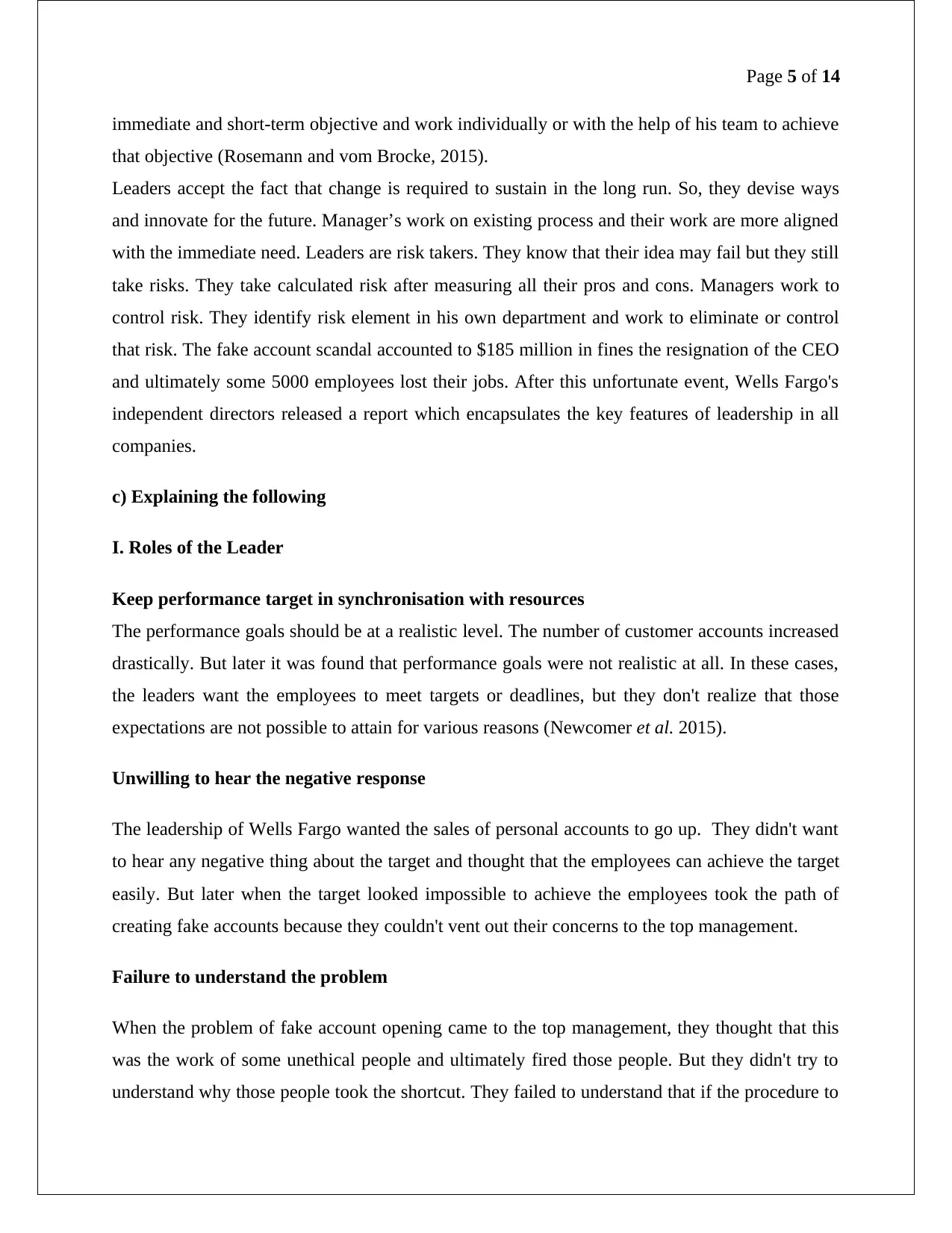
Page 5 of 14
immediate and short-term objective and work individually or with the help of his team to achieve
that objective (Rosemann and vom Brocke, 2015).
Leaders accept the fact that change is required to sustain in the long run. So, they devise ways
and innovate for the future. Manager’s work on existing process and their work are more aligned
with the immediate need. Leaders are risk takers. They know that their idea may fail but they still
take risks. They take calculated risk after measuring all their pros and cons. Managers work to
control risk. They identify risk element in his own department and work to eliminate or control
that risk. The fake account scandal accounted to $185 million in fines the resignation of the CEO
and ultimately some 5000 employees lost their jobs. After this unfortunate event, Wells Fargo's
independent directors released a report which encapsulates the key features of leadership in all
companies.
c) Explaining the following
I. Roles of the Leader
Keep performance target in synchronisation with resources
The performance goals should be at a realistic level. The number of customer accounts increased
drastically. But later it was found that performance goals were not realistic at all. In these cases,
the leaders want the employees to meet targets or deadlines, but they don't realize that those
expectations are not possible to attain for various reasons (Newcomer et al. 2015).
Unwilling to hear the negative response
The leadership of Wells Fargo wanted the sales of personal accounts to go up. They didn't want
to hear any negative thing about the target and thought that the employees can achieve the target
easily. But later when the target looked impossible to achieve the employees took the path of
creating fake accounts because they couldn't vent out their concerns to the top management.
Failure to understand the problem
When the problem of fake account opening came to the top management, they thought that this
was the work of some unethical people and ultimately fired those people. But they didn't try to
understand why those people took the shortcut. They failed to understand that if the procedure to
immediate and short-term objective and work individually or with the help of his team to achieve
that objective (Rosemann and vom Brocke, 2015).
Leaders accept the fact that change is required to sustain in the long run. So, they devise ways
and innovate for the future. Manager’s work on existing process and their work are more aligned
with the immediate need. Leaders are risk takers. They know that their idea may fail but they still
take risks. They take calculated risk after measuring all their pros and cons. Managers work to
control risk. They identify risk element in his own department and work to eliminate or control
that risk. The fake account scandal accounted to $185 million in fines the resignation of the CEO
and ultimately some 5000 employees lost their jobs. After this unfortunate event, Wells Fargo's
independent directors released a report which encapsulates the key features of leadership in all
companies.
c) Explaining the following
I. Roles of the Leader
Keep performance target in synchronisation with resources
The performance goals should be at a realistic level. The number of customer accounts increased
drastically. But later it was found that performance goals were not realistic at all. In these cases,
the leaders want the employees to meet targets or deadlines, but they don't realize that those
expectations are not possible to attain for various reasons (Newcomer et al. 2015).
Unwilling to hear the negative response
The leadership of Wells Fargo wanted the sales of personal accounts to go up. They didn't want
to hear any negative thing about the target and thought that the employees can achieve the target
easily. But later when the target looked impossible to achieve the employees took the path of
creating fake accounts because they couldn't vent out their concerns to the top management.
Failure to understand the problem
When the problem of fake account opening came to the top management, they thought that this
was the work of some unethical people and ultimately fired those people. But they didn't try to
understand why those people took the shortcut. They failed to understand that if the procedure to
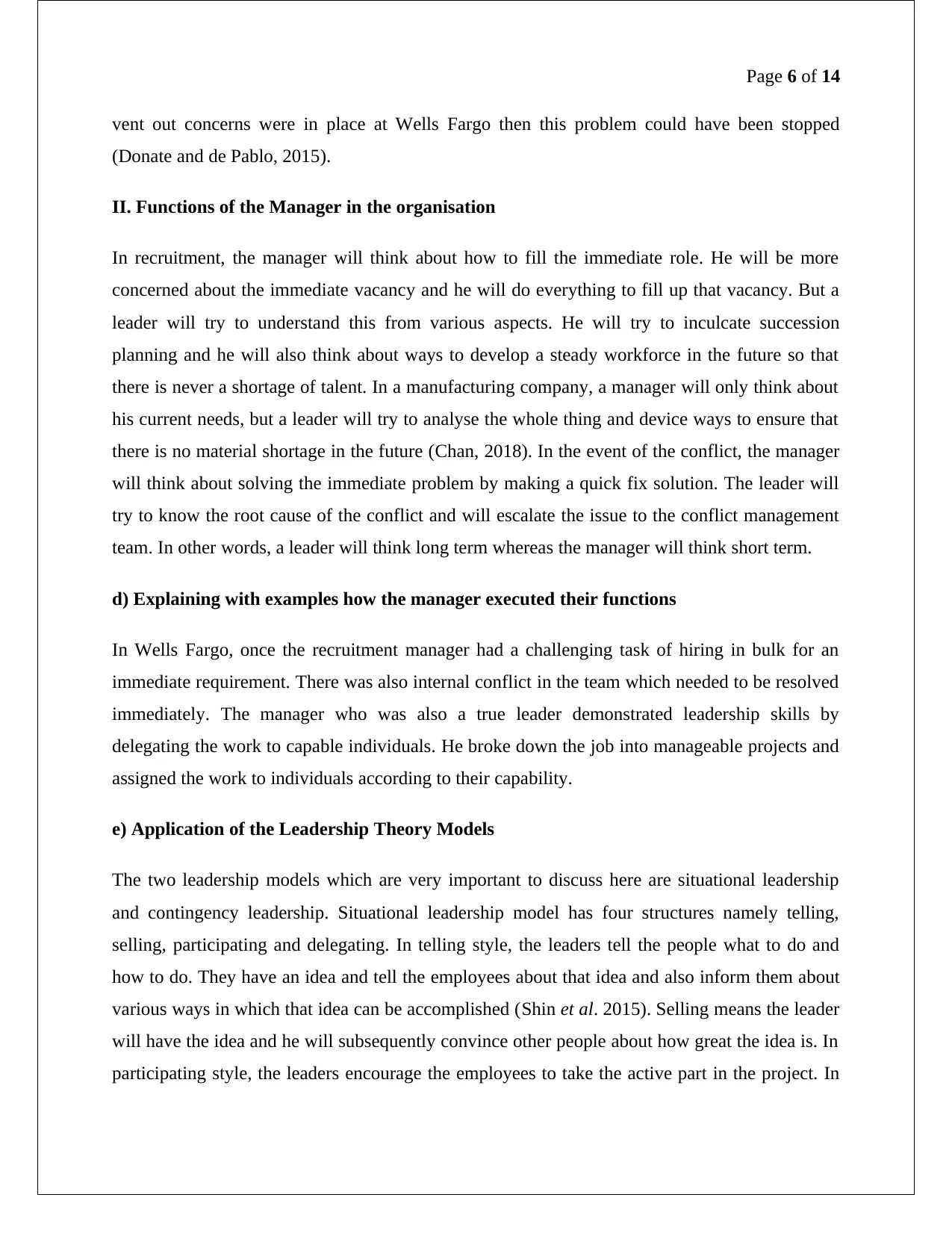
Page 6 of 14
vent out concerns were in place at Wells Fargo then this problem could have been stopped
(Donate and de Pablo, 2015).
II. Functions of the Manager in the organisation
In recruitment, the manager will think about how to fill the immediate role. He will be more
concerned about the immediate vacancy and he will do everything to fill up that vacancy. But a
leader will try to understand this from various aspects. He will try to inculcate succession
planning and he will also think about ways to develop a steady workforce in the future so that
there is never a shortage of talent. In a manufacturing company, a manager will only think about
his current needs, but a leader will try to analyse the whole thing and device ways to ensure that
there is no material shortage in the future (Chan, 2018). In the event of the conflict, the manager
will think about solving the immediate problem by making a quick fix solution. The leader will
try to know the root cause of the conflict and will escalate the issue to the conflict management
team. In other words, a leader will think long term whereas the manager will think short term.
d) Explaining with examples how the manager executed their functions
In Wells Fargo, once the recruitment manager had a challenging task of hiring in bulk for an
immediate requirement. There was also internal conflict in the team which needed to be resolved
immediately. The manager who was also a true leader demonstrated leadership skills by
delegating the work to capable individuals. He broke down the job into manageable projects and
assigned the work to individuals according to their capability.
e) Application of the Leadership Theory Models
The two leadership models which are very important to discuss here are situational leadership
and contingency leadership. Situational leadership model has four structures namely telling,
selling, participating and delegating. In telling style, the leaders tell the people what to do and
how to do. They have an idea and tell the employees about that idea and also inform them about
various ways in which that idea can be accomplished (Shin et al. 2015). Selling means the leader
will have the idea and he will subsequently convince other people about how great the idea is. In
participating style, the leaders encourage the employees to take the active part in the project. In
vent out concerns were in place at Wells Fargo then this problem could have been stopped
(Donate and de Pablo, 2015).
II. Functions of the Manager in the organisation
In recruitment, the manager will think about how to fill the immediate role. He will be more
concerned about the immediate vacancy and he will do everything to fill up that vacancy. But a
leader will try to understand this from various aspects. He will try to inculcate succession
planning and he will also think about ways to develop a steady workforce in the future so that
there is never a shortage of talent. In a manufacturing company, a manager will only think about
his current needs, but a leader will try to analyse the whole thing and device ways to ensure that
there is no material shortage in the future (Chan, 2018). In the event of the conflict, the manager
will think about solving the immediate problem by making a quick fix solution. The leader will
try to know the root cause of the conflict and will escalate the issue to the conflict management
team. In other words, a leader will think long term whereas the manager will think short term.
d) Explaining with examples how the manager executed their functions
In Wells Fargo, once the recruitment manager had a challenging task of hiring in bulk for an
immediate requirement. There was also internal conflict in the team which needed to be resolved
immediately. The manager who was also a true leader demonstrated leadership skills by
delegating the work to capable individuals. He broke down the job into manageable projects and
assigned the work to individuals according to their capability.
e) Application of the Leadership Theory Models
The two leadership models which are very important to discuss here are situational leadership
and contingency leadership. Situational leadership model has four structures namely telling,
selling, participating and delegating. In telling style, the leaders tell the people what to do and
how to do. They have an idea and tell the employees about that idea and also inform them about
various ways in which that idea can be accomplished (Shin et al. 2015). Selling means the leader
will have the idea and he will subsequently convince other people about how great the idea is. In
participating style, the leaders encourage the employees to take the active part in the project. In
⊘ This is a preview!⊘
Do you want full access?
Subscribe today to unlock all pages.

Trusted by 1+ million students worldwide
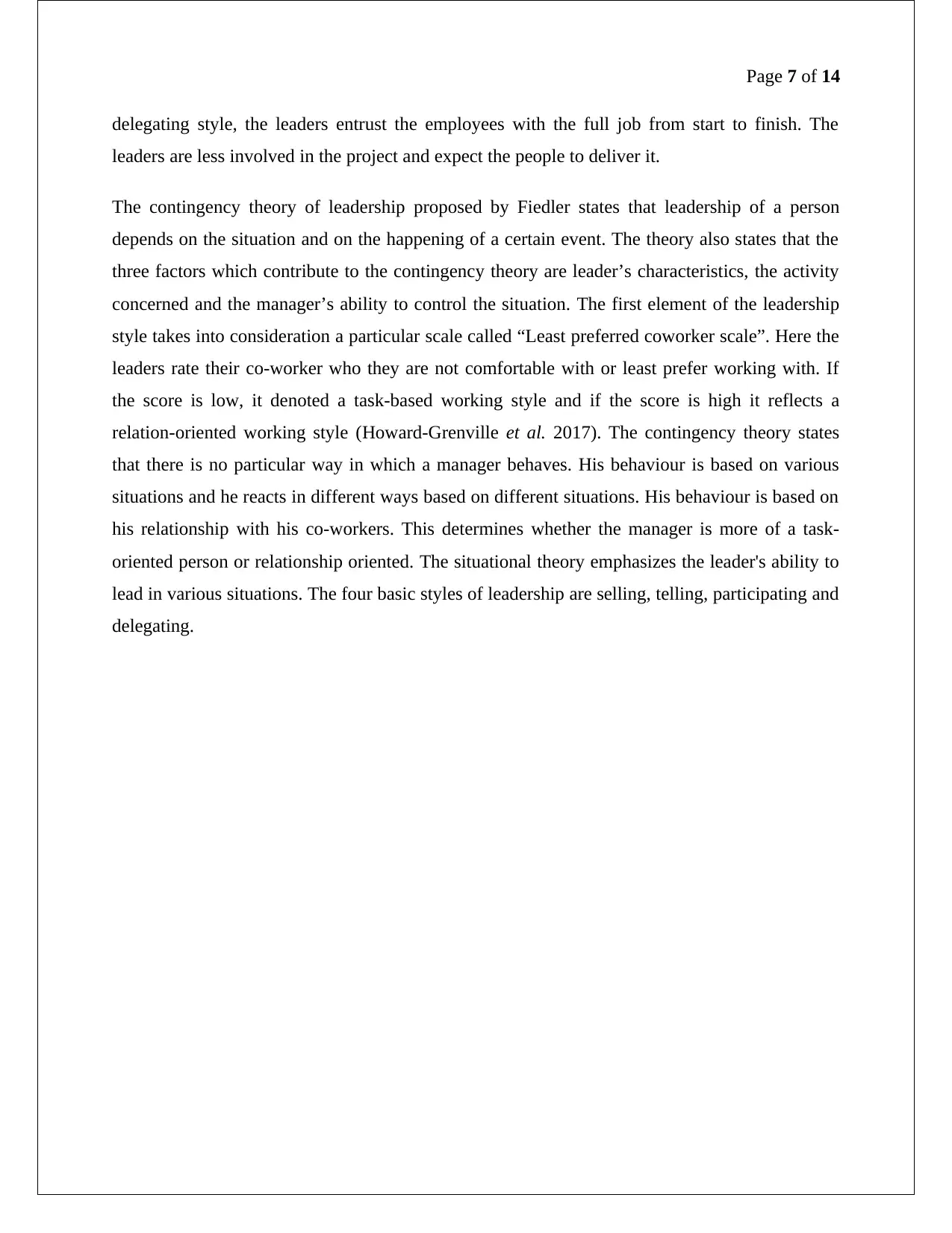
Page 7 of 14
delegating style, the leaders entrust the employees with the full job from start to finish. The
leaders are less involved in the project and expect the people to deliver it.
The contingency theory of leadership proposed by Fiedler states that leadership of a person
depends on the situation and on the happening of a certain event. The theory also states that the
three factors which contribute to the contingency theory are leader’s characteristics, the activity
concerned and the manager’s ability to control the situation. The first element of the leadership
style takes into consideration a particular scale called “Least preferred coworker scale”. Here the
leaders rate their co-worker who they are not comfortable with or least prefer working with. If
the score is low, it denoted a task-based working style and if the score is high it reflects a
relation-oriented working style (Howard-Grenville et al. 2017). The contingency theory states
that there is no particular way in which a manager behaves. His behaviour is based on various
situations and he reacts in different ways based on different situations. His behaviour is based on
his relationship with his co-workers. This determines whether the manager is more of a task-
oriented person or relationship oriented. The situational theory emphasizes the leader's ability to
lead in various situations. The four basic styles of leadership are selling, telling, participating and
delegating.
delegating style, the leaders entrust the employees with the full job from start to finish. The
leaders are less involved in the project and expect the people to deliver it.
The contingency theory of leadership proposed by Fiedler states that leadership of a person
depends on the situation and on the happening of a certain event. The theory also states that the
three factors which contribute to the contingency theory are leader’s characteristics, the activity
concerned and the manager’s ability to control the situation. The first element of the leadership
style takes into consideration a particular scale called “Least preferred coworker scale”. Here the
leaders rate their co-worker who they are not comfortable with or least prefer working with. If
the score is low, it denoted a task-based working style and if the score is high it reflects a
relation-oriented working style (Howard-Grenville et al. 2017). The contingency theory states
that there is no particular way in which a manager behaves. His behaviour is based on various
situations and he reacts in different ways based on different situations. His behaviour is based on
his relationship with his co-workers. This determines whether the manager is more of a task-
oriented person or relationship oriented. The situational theory emphasizes the leader's ability to
lead in various situations. The four basic styles of leadership are selling, telling, participating and
delegating.
Paraphrase This Document
Need a fresh take? Get an instant paraphrase of this document with our AI Paraphraser
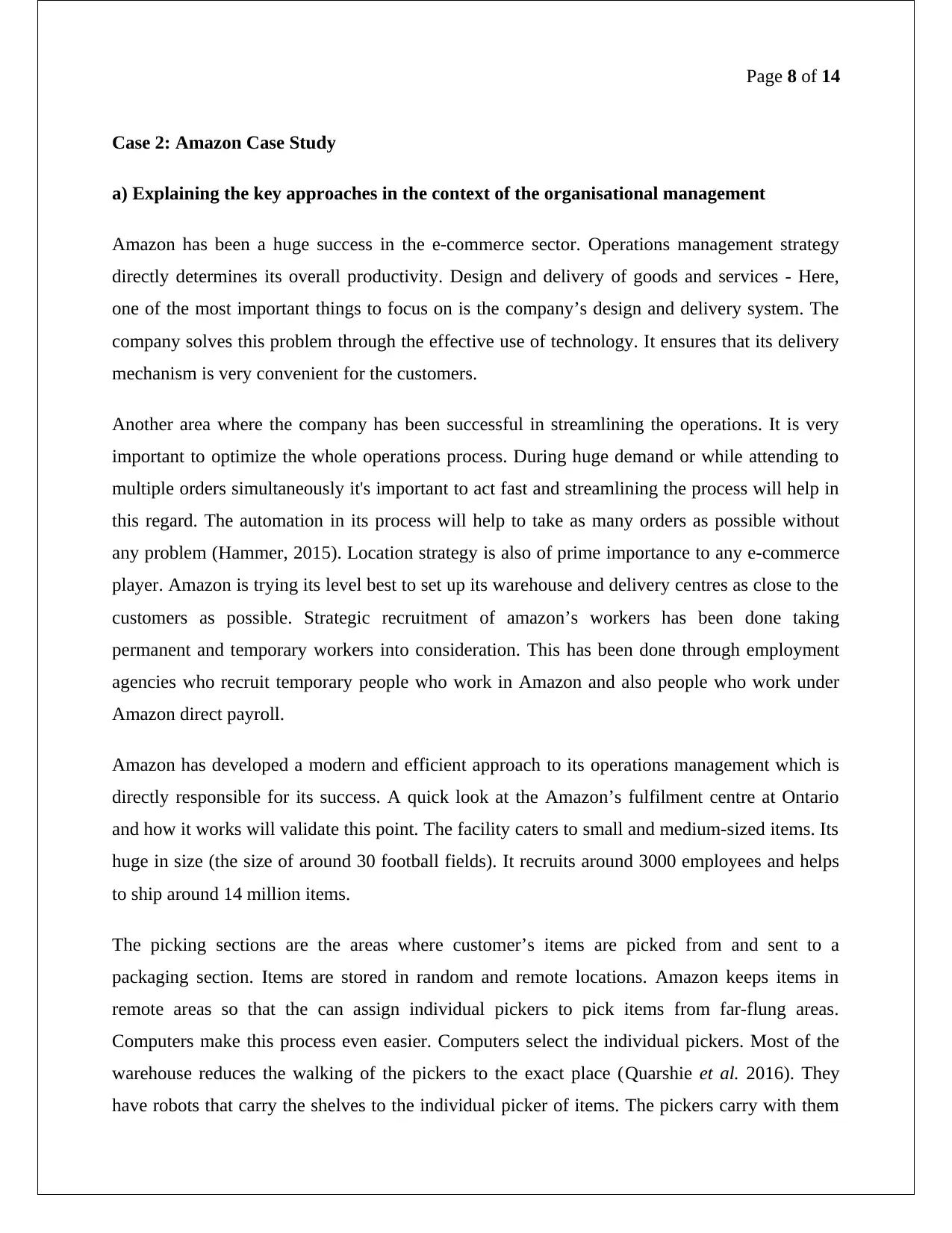
Page 8 of 14
Case 2: Amazon Case Study
a) Explaining the key approaches in the context of the organisational management
Amazon has been a huge success in the e-commerce sector. Operations management strategy
directly determines its overall productivity. Design and delivery of goods and services - Here,
one of the most important things to focus on is the company’s design and delivery system. The
company solves this problem through the effective use of technology. It ensures that its delivery
mechanism is very convenient for the customers.
Another area where the company has been successful in streamlining the operations. It is very
important to optimize the whole operations process. During huge demand or while attending to
multiple orders simultaneously it's important to act fast and streamlining the process will help in
this regard. The automation in its process will help to take as many orders as possible without
any problem (Hammer, 2015). Location strategy is also of prime importance to any e-commerce
player. Amazon is trying its level best to set up its warehouse and delivery centres as close to the
customers as possible. Strategic recruitment of amazon’s workers has been done taking
permanent and temporary workers into consideration. This has been done through employment
agencies who recruit temporary people who work in Amazon and also people who work under
Amazon direct payroll.
Amazon has developed a modern and efficient approach to its operations management which is
directly responsible for its success. A quick look at the Amazon’s fulfilment centre at Ontario
and how it works will validate this point. The facility caters to small and medium-sized items. Its
huge in size (the size of around 30 football fields). It recruits around 3000 employees and helps
to ship around 14 million items.
The picking sections are the areas where customer’s items are picked from and sent to a
packaging section. Items are stored in random and remote locations. Amazon keeps items in
remote areas so that the can assign individual pickers to pick items from far-flung areas.
Computers make this process even easier. Computers select the individual pickers. Most of the
warehouse reduces the walking of the pickers to the exact place (Quarshie et al. 2016). They
have robots that carry the shelves to the individual picker of items. The pickers carry with them
Case 2: Amazon Case Study
a) Explaining the key approaches in the context of the organisational management
Amazon has been a huge success in the e-commerce sector. Operations management strategy
directly determines its overall productivity. Design and delivery of goods and services - Here,
one of the most important things to focus on is the company’s design and delivery system. The
company solves this problem through the effective use of technology. It ensures that its delivery
mechanism is very convenient for the customers.
Another area where the company has been successful in streamlining the operations. It is very
important to optimize the whole operations process. During huge demand or while attending to
multiple orders simultaneously it's important to act fast and streamlining the process will help in
this regard. The automation in its process will help to take as many orders as possible without
any problem (Hammer, 2015). Location strategy is also of prime importance to any e-commerce
player. Amazon is trying its level best to set up its warehouse and delivery centres as close to the
customers as possible. Strategic recruitment of amazon’s workers has been done taking
permanent and temporary workers into consideration. This has been done through employment
agencies who recruit temporary people who work in Amazon and also people who work under
Amazon direct payroll.
Amazon has developed a modern and efficient approach to its operations management which is
directly responsible for its success. A quick look at the Amazon’s fulfilment centre at Ontario
and how it works will validate this point. The facility caters to small and medium-sized items. Its
huge in size (the size of around 30 football fields). It recruits around 3000 employees and helps
to ship around 14 million items.
The picking sections are the areas where customer’s items are picked from and sent to a
packaging section. Items are stored in random and remote locations. Amazon keeps items in
remote areas so that the can assign individual pickers to pick items from far-flung areas.
Computers make this process even easier. Computers select the individual pickers. Most of the
warehouse reduces the walking of the pickers to the exact place (Quarshie et al. 2016). They
have robots that carry the shelves to the individual picker of items. The pickers carry with them
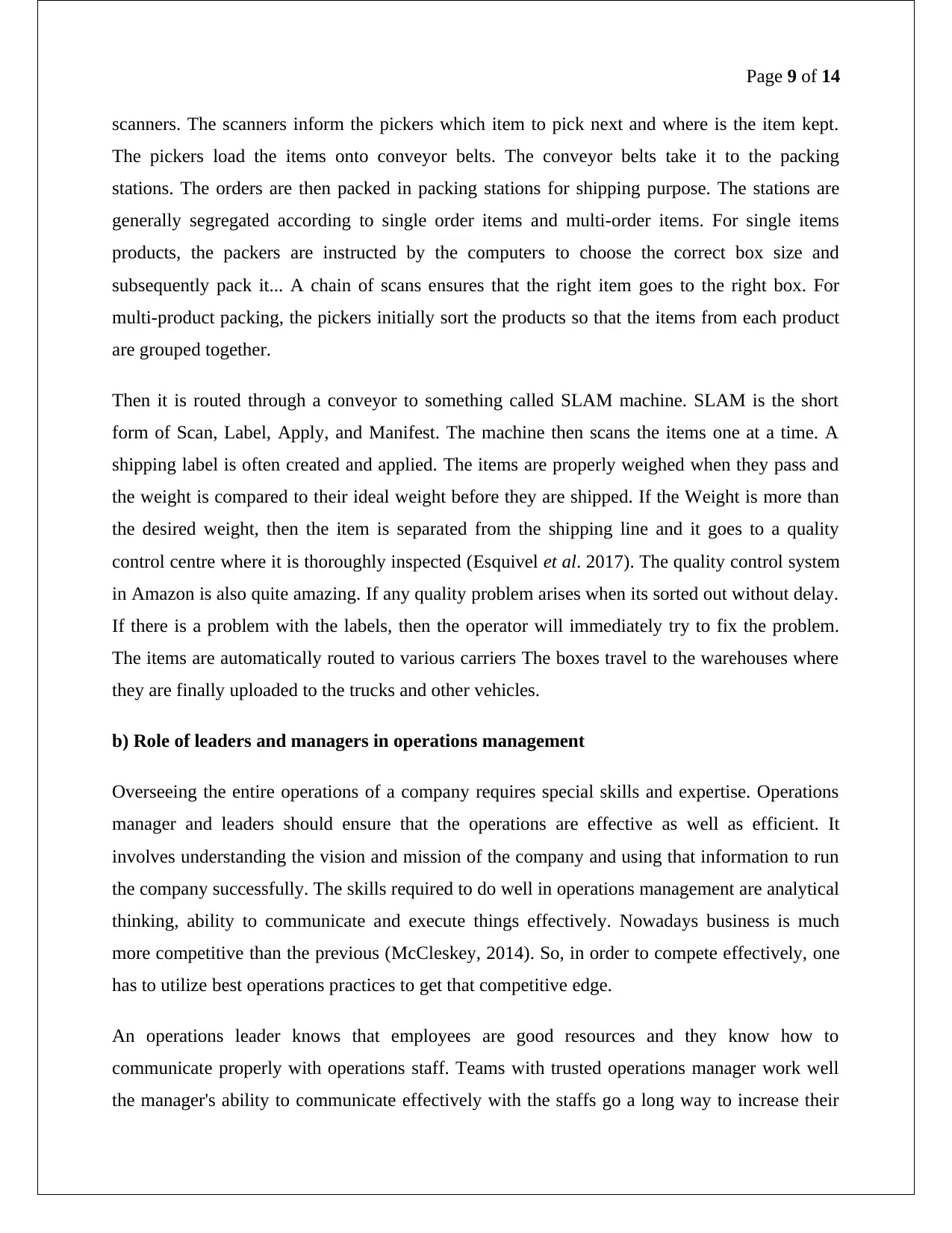
Page 9 of 14
scanners. The scanners inform the pickers which item to pick next and where is the item kept.
The pickers load the items onto conveyor belts. The conveyor belts take it to the packing
stations. The orders are then packed in packing stations for shipping purpose. The stations are
generally segregated according to single order items and multi-order items. For single items
products, the packers are instructed by the computers to choose the correct box size and
subsequently pack it... A chain of scans ensures that the right item goes to the right box. For
multi-product packing, the pickers initially sort the products so that the items from each product
are grouped together.
Then it is routed through a conveyor to something called SLAM machine. SLAM is the short
form of Scan, Label, Apply, and Manifest. The machine then scans the items one at a time. A
shipping label is often created and applied. The items are properly weighed when they pass and
the weight is compared to their ideal weight before they are shipped. If the Weight is more than
the desired weight, then the item is separated from the shipping line and it goes to a quality
control centre where it is thoroughly inspected (Esquivel et al. 2017). The quality control system
in Amazon is also quite amazing. If any quality problem arises when its sorted out without delay.
If there is a problem with the labels, then the operator will immediately try to fix the problem.
The items are automatically routed to various carriers The boxes travel to the warehouses where
they are finally uploaded to the trucks and other vehicles.
b) Role of leaders and managers in operations management
Overseeing the entire operations of a company requires special skills and expertise. Operations
manager and leaders should ensure that the operations are effective as well as efficient. It
involves understanding the vision and mission of the company and using that information to run
the company successfully. The skills required to do well in operations management are analytical
thinking, ability to communicate and execute things effectively. Nowadays business is much
more competitive than the previous (McCleskey, 2014). So, in order to compete effectively, one
has to utilize best operations practices to get that competitive edge.
An operations leader knows that employees are good resources and they know how to
communicate properly with operations staff. Teams with trusted operations manager work well
the manager's ability to communicate effectively with the staffs go a long way to increase their
scanners. The scanners inform the pickers which item to pick next and where is the item kept.
The pickers load the items onto conveyor belts. The conveyor belts take it to the packing
stations. The orders are then packed in packing stations for shipping purpose. The stations are
generally segregated according to single order items and multi-order items. For single items
products, the packers are instructed by the computers to choose the correct box size and
subsequently pack it... A chain of scans ensures that the right item goes to the right box. For
multi-product packing, the pickers initially sort the products so that the items from each product
are grouped together.
Then it is routed through a conveyor to something called SLAM machine. SLAM is the short
form of Scan, Label, Apply, and Manifest. The machine then scans the items one at a time. A
shipping label is often created and applied. The items are properly weighed when they pass and
the weight is compared to their ideal weight before they are shipped. If the Weight is more than
the desired weight, then the item is separated from the shipping line and it goes to a quality
control centre where it is thoroughly inspected (Esquivel et al. 2017). The quality control system
in Amazon is also quite amazing. If any quality problem arises when its sorted out without delay.
If there is a problem with the labels, then the operator will immediately try to fix the problem.
The items are automatically routed to various carriers The boxes travel to the warehouses where
they are finally uploaded to the trucks and other vehicles.
b) Role of leaders and managers in operations management
Overseeing the entire operations of a company requires special skills and expertise. Operations
manager and leaders should ensure that the operations are effective as well as efficient. It
involves understanding the vision and mission of the company and using that information to run
the company successfully. The skills required to do well in operations management are analytical
thinking, ability to communicate and execute things effectively. Nowadays business is much
more competitive than the previous (McCleskey, 2014). So, in order to compete effectively, one
has to utilize best operations practices to get that competitive edge.
An operations leader knows that employees are good resources and they know how to
communicate properly with operations staff. Teams with trusted operations manager work well
the manager's ability to communicate effectively with the staffs go a long way to increase their
⊘ This is a preview!⊘
Do you want full access?
Subscribe today to unlock all pages.

Trusted by 1+ million students worldwide
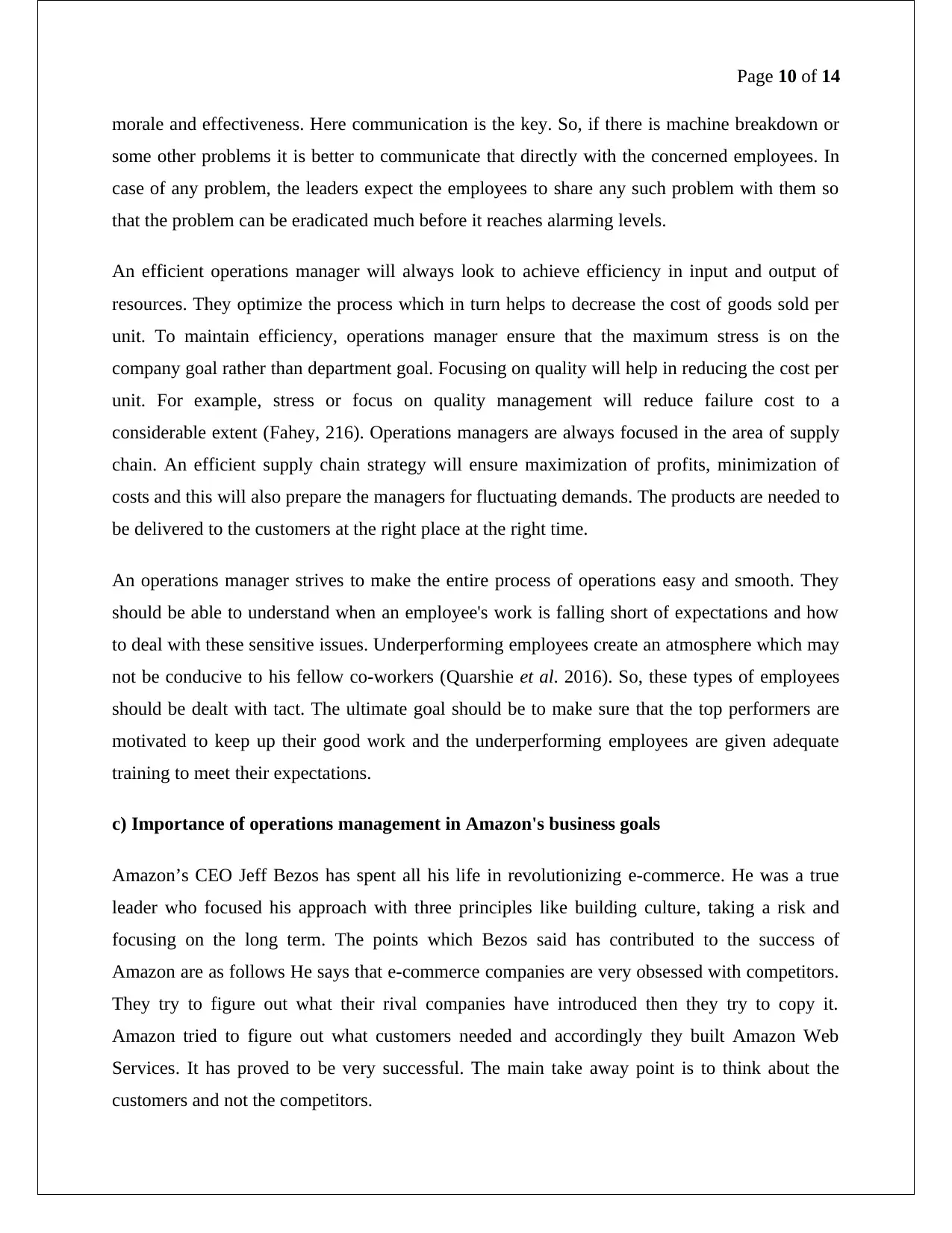
Page 10 of 14
morale and effectiveness. Here communication is the key. So, if there is machine breakdown or
some other problems it is better to communicate that directly with the concerned employees. In
case of any problem, the leaders expect the employees to share any such problem with them so
that the problem can be eradicated much before it reaches alarming levels.
An efficient operations manager will always look to achieve efficiency in input and output of
resources. They optimize the process which in turn helps to decrease the cost of goods sold per
unit. To maintain efficiency, operations manager ensure that the maximum stress is on the
company goal rather than department goal. Focusing on quality will help in reducing the cost per
unit. For example, stress or focus on quality management will reduce failure cost to a
considerable extent (Fahey, 216). Operations managers are always focused in the area of supply
chain. An efficient supply chain strategy will ensure maximization of profits, minimization of
costs and this will also prepare the managers for fluctuating demands. The products are needed to
be delivered to the customers at the right place at the right time.
An operations manager strives to make the entire process of operations easy and smooth. They
should be able to understand when an employee's work is falling short of expectations and how
to deal with these sensitive issues. Underperforming employees create an atmosphere which may
not be conducive to his fellow co-workers (Quarshie et al. 2016). So, these types of employees
should be dealt with tact. The ultimate goal should be to make sure that the top performers are
motivated to keep up their good work and the underperforming employees are given adequate
training to meet their expectations.
c) Importance of operations management in Amazon's business goals
Amazon’s CEO Jeff Bezos has spent all his life in revolutionizing e-commerce. He was a true
leader who focused his approach with three principles like building culture, taking a risk and
focusing on the long term. The points which Bezos said has contributed to the success of
Amazon are as follows He says that e-commerce companies are very obsessed with competitors.
They try to figure out what their rival companies have introduced then they try to copy it.
Amazon tried to figure out what customers needed and accordingly they built Amazon Web
Services. It has proved to be very successful. The main take away point is to think about the
customers and not the competitors.
morale and effectiveness. Here communication is the key. So, if there is machine breakdown or
some other problems it is better to communicate that directly with the concerned employees. In
case of any problem, the leaders expect the employees to share any such problem with them so
that the problem can be eradicated much before it reaches alarming levels.
An efficient operations manager will always look to achieve efficiency in input and output of
resources. They optimize the process which in turn helps to decrease the cost of goods sold per
unit. To maintain efficiency, operations manager ensure that the maximum stress is on the
company goal rather than department goal. Focusing on quality will help in reducing the cost per
unit. For example, stress or focus on quality management will reduce failure cost to a
considerable extent (Fahey, 216). Operations managers are always focused in the area of supply
chain. An efficient supply chain strategy will ensure maximization of profits, minimization of
costs and this will also prepare the managers for fluctuating demands. The products are needed to
be delivered to the customers at the right place at the right time.
An operations manager strives to make the entire process of operations easy and smooth. They
should be able to understand when an employee's work is falling short of expectations and how
to deal with these sensitive issues. Underperforming employees create an atmosphere which may
not be conducive to his fellow co-workers (Quarshie et al. 2016). So, these types of employees
should be dealt with tact. The ultimate goal should be to make sure that the top performers are
motivated to keep up their good work and the underperforming employees are given adequate
training to meet their expectations.
c) Importance of operations management in Amazon's business goals
Amazon’s CEO Jeff Bezos has spent all his life in revolutionizing e-commerce. He was a true
leader who focused his approach with three principles like building culture, taking a risk and
focusing on the long term. The points which Bezos said has contributed to the success of
Amazon are as follows He says that e-commerce companies are very obsessed with competitors.
They try to figure out what their rival companies have introduced then they try to copy it.
Amazon tried to figure out what customers needed and accordingly they built Amazon Web
Services. It has proved to be very successful. The main take away point is to think about the
customers and not the competitors.
Paraphrase This Document
Need a fresh take? Get an instant paraphrase of this document with our AI Paraphraser
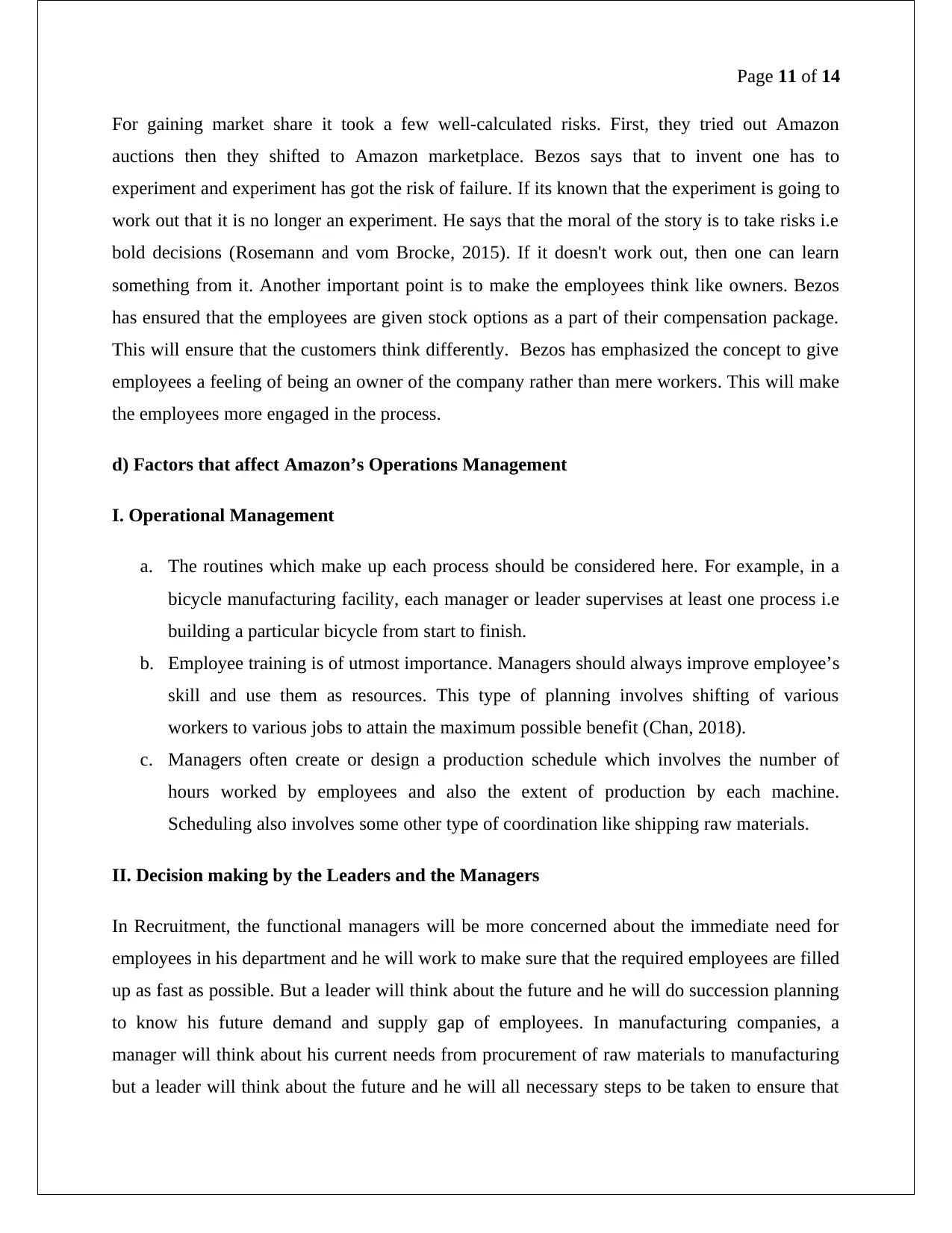
Page 11 of 14
For gaining market share it took a few well-calculated risks. First, they tried out Amazon
auctions then they shifted to Amazon marketplace. Bezos says that to invent one has to
experiment and experiment has got the risk of failure. If its known that the experiment is going to
work out that it is no longer an experiment. He says that the moral of the story is to take risks i.e
bold decisions (Rosemann and vom Brocke, 2015). If it doesn't work out, then one can learn
something from it. Another important point is to make the employees think like owners. Bezos
has ensured that the employees are given stock options as a part of their compensation package.
This will ensure that the customers think differently. Bezos has emphasized the concept to give
employees a feeling of being an owner of the company rather than mere workers. This will make
the employees more engaged in the process.
d) Factors that affect Amazon’s Operations Management
I. Operational Management
a. The routines which make up each process should be considered here. For example, in a
bicycle manufacturing facility, each manager or leader supervises at least one process i.e
building a particular bicycle from start to finish.
b. Employee training is of utmost importance. Managers should always improve employee’s
skill and use them as resources. This type of planning involves shifting of various
workers to various jobs to attain the maximum possible benefit (Chan, 2018).
c. Managers often create or design a production schedule which involves the number of
hours worked by employees and also the extent of production by each machine.
Scheduling also involves some other type of coordination like shipping raw materials.
II. Decision making by the Leaders and the Managers
In Recruitment, the functional managers will be more concerned about the immediate need for
employees in his department and he will work to make sure that the required employees are filled
up as fast as possible. But a leader will think about the future and he will do succession planning
to know his future demand and supply gap of employees. In manufacturing companies, a
manager will think about his current needs from procurement of raw materials to manufacturing
but a leader will think about the future and he will all necessary steps to be taken to ensure that
For gaining market share it took a few well-calculated risks. First, they tried out Amazon
auctions then they shifted to Amazon marketplace. Bezos says that to invent one has to
experiment and experiment has got the risk of failure. If its known that the experiment is going to
work out that it is no longer an experiment. He says that the moral of the story is to take risks i.e
bold decisions (Rosemann and vom Brocke, 2015). If it doesn't work out, then one can learn
something from it. Another important point is to make the employees think like owners. Bezos
has ensured that the employees are given stock options as a part of their compensation package.
This will ensure that the customers think differently. Bezos has emphasized the concept to give
employees a feeling of being an owner of the company rather than mere workers. This will make
the employees more engaged in the process.
d) Factors that affect Amazon’s Operations Management
I. Operational Management
a. The routines which make up each process should be considered here. For example, in a
bicycle manufacturing facility, each manager or leader supervises at least one process i.e
building a particular bicycle from start to finish.
b. Employee training is of utmost importance. Managers should always improve employee’s
skill and use them as resources. This type of planning involves shifting of various
workers to various jobs to attain the maximum possible benefit (Chan, 2018).
c. Managers often create or design a production schedule which involves the number of
hours worked by employees and also the extent of production by each machine.
Scheduling also involves some other type of coordination like shipping raw materials.
II. Decision making by the Leaders and the Managers
In Recruitment, the functional managers will be more concerned about the immediate need for
employees in his department and he will work to make sure that the required employees are filled
up as fast as possible. But a leader will think about the future and he will do succession planning
to know his future demand and supply gap of employees. In manufacturing companies, a
manager will think about his current needs from procurement of raw materials to manufacturing
but a leader will think about the future and he will all necessary steps to be taken to ensure that
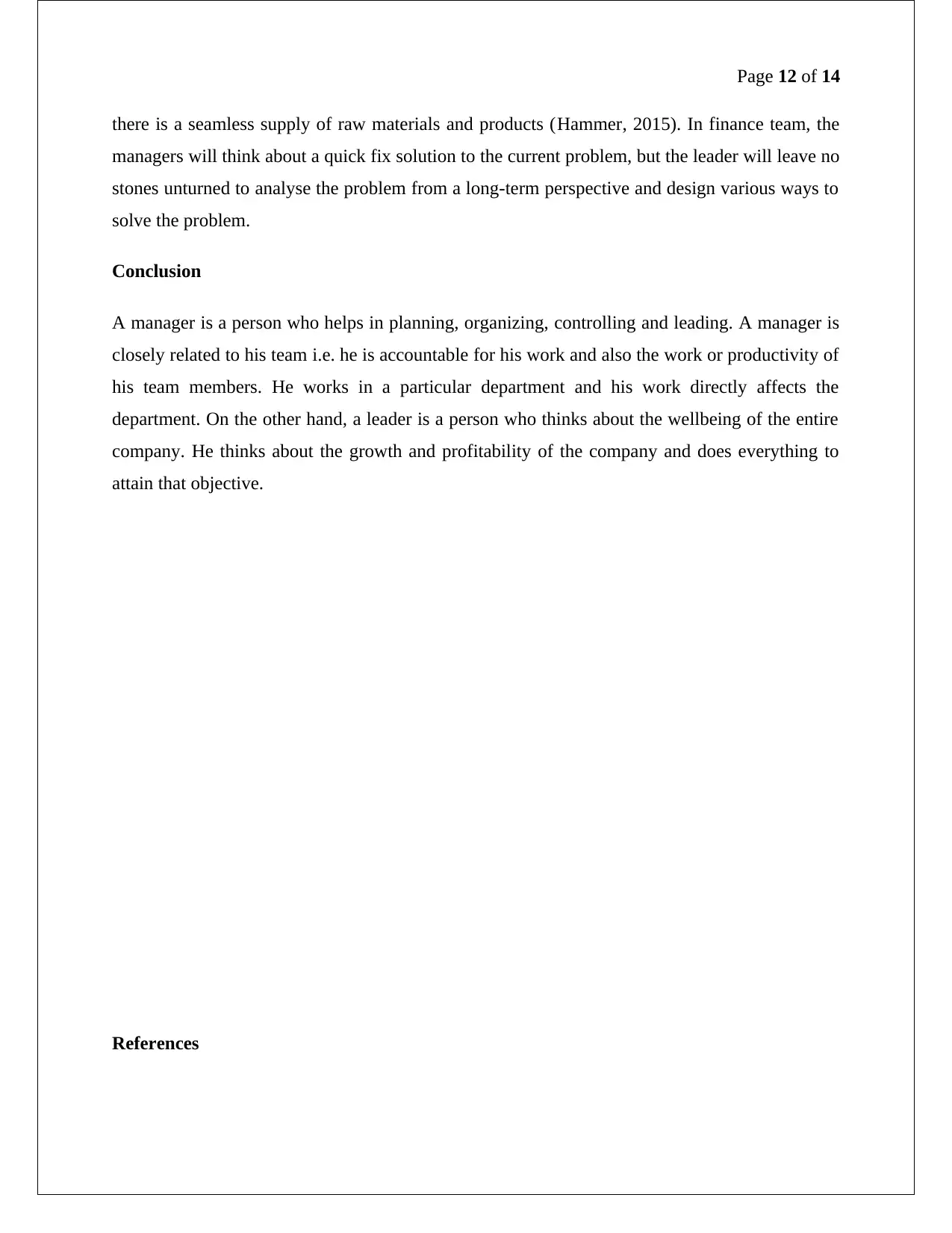
Page 12 of 14
there is a seamless supply of raw materials and products (Hammer, 2015). In finance team, the
managers will think about a quick fix solution to the current problem, but the leader will leave no
stones unturned to analyse the problem from a long-term perspective and design various ways to
solve the problem.
Conclusion
A manager is a person who helps in planning, organizing, controlling and leading. A manager is
closely related to his team i.e. he is accountable for his work and also the work or productivity of
his team members. He works in a particular department and his work directly affects the
department. On the other hand, a leader is a person who thinks about the wellbeing of the entire
company. He thinks about the growth and profitability of the company and does everything to
attain that objective.
References
there is a seamless supply of raw materials and products (Hammer, 2015). In finance team, the
managers will think about a quick fix solution to the current problem, but the leader will leave no
stones unturned to analyse the problem from a long-term perspective and design various ways to
solve the problem.
Conclusion
A manager is a person who helps in planning, organizing, controlling and leading. A manager is
closely related to his team i.e. he is accountable for his work and also the work or productivity of
his team members. He works in a particular department and his work directly affects the
department. On the other hand, a leader is a person who thinks about the wellbeing of the entire
company. He thinks about the growth and profitability of the company and does everything to
attain that objective.
References
⊘ This is a preview!⊘
Do you want full access?
Subscribe today to unlock all pages.

Trusted by 1+ million students worldwide
1 out of 14
Related Documents
Your All-in-One AI-Powered Toolkit for Academic Success.
+13062052269
info@desklib.com
Available 24*7 on WhatsApp / Email
![[object Object]](/_next/static/media/star-bottom.7253800d.svg)
Unlock your academic potential
Copyright © 2020–2025 A2Z Services. All Rights Reserved. Developed and managed by ZUCOL.





